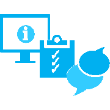SEPs8: Obtaining, Evaluating, and Communicating Information
 Scientists and engineers must be able to communicate clearly and persuasively the ideas and methods they generate. Critiquing and communicating ideas individually and in groups is a critical professional activity. Scientists and engineers must be able to communicate clearly and persuasively the ideas and methods they generate. Critiquing and communicating ideas individually and in groups is a critical professional activity.
Primary (K-2)
Obtaining, evaluating, and communicating information in K–2 builds on prior experiences and uses observations and texts to communicate new information.
- Read grade-appropriate texts and/or use media to obtain scientific and/or technical information to determine patterns in and/or evidence about the natural and designed world(s).
- Describe how specific images (e.g., a diagram showing how a machine works) support a scientific or engineering idea.
- Obtain information using various texts, text features (e.g., headings, tables of contents, glossaries, electronic menus, icons), and other media that will be useful in answering a scientific question and/or supporting a scientific claim.
- Communicate information or design ideas and/or solutions with others in oral and/or written forms using models, drawings, writing, or numbers that provide detail about scientific ideas, practices, and/or design ideas.
Elementary (3-5)
Obtaining, evaluating, and communicating information in 3–5 builds on K–2 experiences and progresses to evaluating the merit and accuracy of ideas and methods.
- Obtain and combine information from books and other reliable media to explain phenomena.
- Read and comprehend grade-appropriate complex texts and/or other reliable media to summarize and obtain scientific and technical ideas and describe how they are supported by evidence.
- Compare and/or combine across complex texts and/or other reliable media to support the engagement in other scientific and/or engineering practices.
- Combine information in written text with that contained in corresponding tables, diagrams, and/or charts to support the engagement in other scientific and/or engineering practices.
- Obtain and combine information from books and/or other reliable media to explain phenomena or solutions to a design problem.
- Communicate scientific and/or technical information orally and/or in written formats, including various forms of media and may include tables, diagrams, and charts.
Middle (6-8)
Obtaining, evaluating, and communicating information in 6–8 builds on K–5 experiences and progresses to evaluating the merit and validity of ideas and methods.
- Critically read scientific texts adapted for classroom use to determine the central ideas and/or obtain scientific and/or technical information to describe patterns in and/or evidence about the natural and designed world(s).
- Integrate qualitative and/or quantitative scientific and/or technical information in written text with that contained in media and visual displays to clarify claims and findings.
- Gather, read, synthesize information from multiple appropriate sources and assess the credibility, accuracy, and possible bias of each publication and methods used, and describe how they are supported or not supported by evidence.
- Evaluate data, hypotheses, and/or conclusions in scientific and technical texts in light of competing information or accounts.
- Communicate scientific and/or technical information (e.g. about a proposed object, tool, process, system) in writing and/or through oral presentations.
High (9-12)
Obtaining, evaluating, and communicating information in 9–12 builds on K–8 experiences and progresses to evaluating the validity and reliability of the claims, methods, and designs.
- Critically read scientific literature adapted for classroom use to determine the central ideas or conclusions and/or to obtain scientific and/or technical information to summarize complex evidence, concepts, processes, or information presented in a text by paraphrasing them in simpler but still accurate terms.
- Compare, integrate and evaluate sources of information presented in different media or formats (e.g., visually, quantitatively) as well as in words in order to address a scientific question or solve a problem.
- Gather, read, and evaluate scientific and/or technical information from multiple authoritative sources, assessing the evidence and usefulness of each source.
- Evaluate the validity and reliability of and/or synthesize multiple claims, methods, and/or designs that appear in scientific and technical texts or media reports, verifying the data when possible.
- Communicate scientific and/or technical information or ideas (e.g. about phenomena and/or the process of development and the design and performance of a proposed process or system) in multiple formats (including orally, graphically, textually, and mathematically).
Any education in science and engineering needs to develop students’ ability to read and produce domain-specific text. As such, every science or engineering lesson is in part a language lesson, particularly reading and producing the genres of texts that
are intrinsic to science and engineering.
Being able to read, interpret, and produce scientific and technical text is a fundamental practice of science and engineering, as is the ability to communicate clearly and persuasively. Being a critical consumer of information about science and engineering
requires the ability to read or view reports of scientific or technological advances or applications (whether found in the press, or the Internet, or in a town meeting) and to recognize the salient ideas, identify sources of error and methodological
flaws, distinguish observations from inferences, arguments from explanations, and claims from evidence. Scientists and engineers employ multiple sources to obtain information used to evaluate the merit and validity of claims, methods, and designs. Communicating
information, evidence, and ideas can be done in multiple ways: using tables, diagrams, graphs, models, interactive displays, and equations as well as orally, in writing, and through extended discussions. |